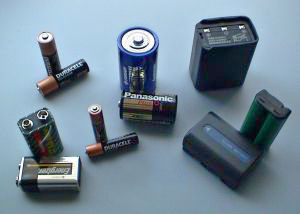Electric battery
(Redirected from Battery (electricity))
Electric battery is a device consisting of one or more electrochemical cells with external connections for powering electrical devices such as flashlights, smartphones, and electric cars. When a battery is supplying electric power, its positive terminal is the cathode and its negative terminal is the anode. The terminal marked negative is the source of electrons that when connected to an external circuit will flow and deliver energy to an external device. When a battery is connected to an external circuit, electrolytes are able to move as ions within, allowing the chemical reactions to be completed at the separate terminals and so deliver energy to the external circuit. It is the movement of those ions within the battery which allows current to flow out of the battery to perform work. Historically, the term "battery" specifically referred to a device composed of multiple cells; however, the usage has evolved to include devices composed of a single cell.
History[edit | edit source]
The concept of the electric battery was first demonstrated by Italian physicist Alessandro Volta in 1800 with his invention of the Voltaic pile, which was the first device to produce a steady electric current. Over the decades, the technology of batteries has evolved significantly, leading to the development of various types including the lead-acid battery, invented by Gaston Planté in 1859, and the lithium-ion battery, which was commercialized in the 1990s and has become prevalent in the rechargeable battery market for portable electronics and electric vehicles.
Types of Batteries[edit | edit source]
There are two main types of batteries: primary (disposable) batteries, which are designed to be used once and discarded, and secondary (rechargeable) batteries, which are designed to be recharged and used multiple times. Common types of primary batteries include the alkaline battery and the zinc-carbon battery. Common types of secondary batteries include the lead-acid battery, nickel-cadmium battery (NiCd), nickel-metal hydride battery (NiMH), lithium-ion battery, and lithium polymer battery.
Battery Capacity and Performance[edit | edit source]
The capacity of a battery, usually measured in ampere-hours (Ah) or milliampere-hours (mAh), indicates how much electric charge it can store. Battery performance can degrade over time, a phenomenon known as the memory effect, particularly noted in NiCd batteries, though it is less of an issue in other types. The efficiency, durability, and cost of batteries vary across different types, affecting their suitability for various applications.
Environmental Impact[edit | edit source]
The production, usage, and disposal of batteries can have significant environmental impacts. Chemicals and heavy metals from batteries can contaminate soil and water. Recycling programs and regulations aim to reduce the environmental impact of battery disposal, but challenges remain in managing the lifecycle of batteries, especially with the growing use of lithium-ion batteries in electric vehicles.
Future Developments[edit | edit source]
Research into battery technology focuses on increasing capacity, durability, and charging speed while reducing cost and environmental impact. Innovations such as solid-state batteries, which replace the liquid or gel electrolyte with a solid, promise to offer higher energy densities and improved safety. Advances in materials science and engineering are key to the development of next-generation batteries.
Search WikiMD
Ad.Tired of being Overweight? Try W8MD's physician weight loss program.
Semaglutide (Ozempic / Wegovy and Tirzepatide (Mounjaro / Zepbound) available.
Advertise on WikiMD
|
WikiMD's Wellness Encyclopedia |
| Let Food Be Thy Medicine Medicine Thy Food - Hippocrates |
Translate this page: - East Asian
中文,
日本,
한국어,
South Asian
हिन्दी,
தமிழ்,
తెలుగు,
Urdu,
ಕನ್ನಡ,
Southeast Asian
Indonesian,
Vietnamese,
Thai,
မြန်မာဘာသာ,
বাংলা
European
español,
Deutsch,
français,
Greek,
português do Brasil,
polski,
română,
русский,
Nederlands,
norsk,
svenska,
suomi,
Italian
Middle Eastern & African
عربى,
Turkish,
Persian,
Hebrew,
Afrikaans,
isiZulu,
Kiswahili,
Other
Bulgarian,
Hungarian,
Czech,
Swedish,
മലയാളം,
मराठी,
ਪੰਜਾਬੀ,
ગુજરાતી,
Portuguese,
Ukrainian
Medical Disclaimer: WikiMD is not a substitute for professional medical advice. The information on WikiMD is provided as an information resource only, may be incorrect, outdated or misleading, and is not to be used or relied on for any diagnostic or treatment purposes. Please consult your health care provider before making any healthcare decisions or for guidance about a specific medical condition. WikiMD expressly disclaims responsibility, and shall have no liability, for any damages, loss, injury, or liability whatsoever suffered as a result of your reliance on the information contained in this site. By visiting this site you agree to the foregoing terms and conditions, which may from time to time be changed or supplemented by WikiMD. If you do not agree to the foregoing terms and conditions, you should not enter or use this site. See full disclaimer.
Credits:Most images are courtesy of Wikimedia commons, and templates, categories Wikipedia, licensed under CC BY SA or similar.
Contributors: Prab R. Tumpati, MD





